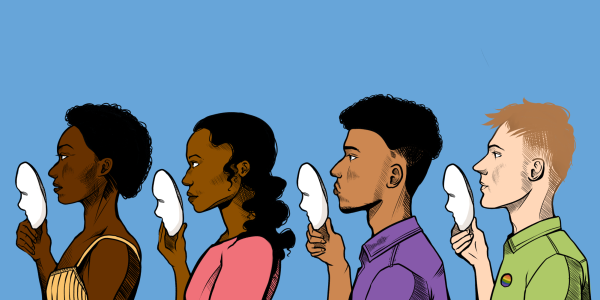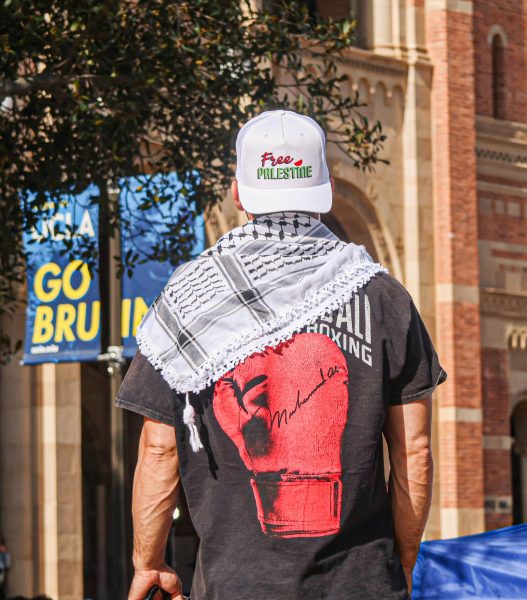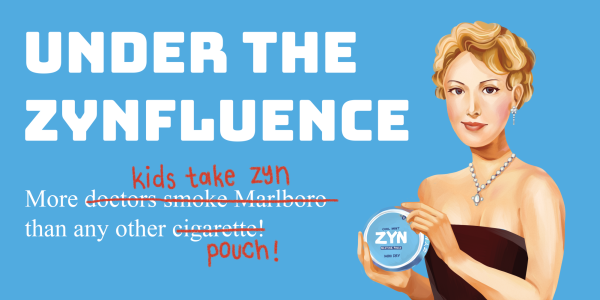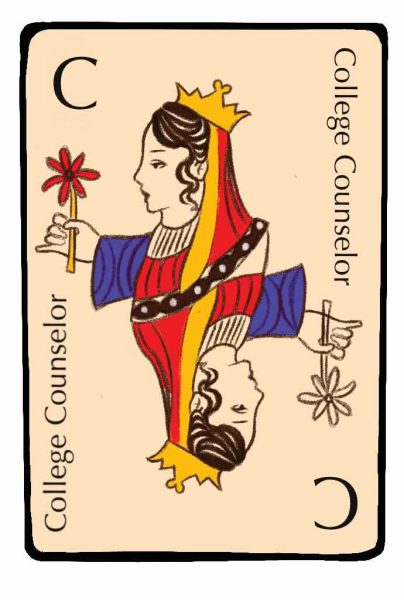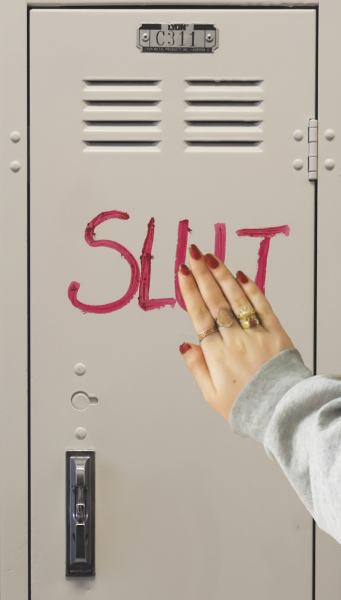Lives on the Line
Students and faculty reflect on the progression of gun violence on school campuses since the deadly shooting in Parkland, Florida.
Illustration by Sophia Musante
Student defends themselves in the face of gun violence, standing in front of a crumbled American flag.
February 17, 2022
Palisades Charter High School (PCHS) senior Maya DeGanyar ’22 turned in her seat to see the whiteboard more clearly. She scribbled down notes and then opened “To Kill a Mockingbird” to the assigned page before the piercing noise of a fire alarm interrupted her train of thought. She started to look around the room for escape routes, holding her friend’s hand closely. One week prior, a mass shooting in Parkland, Florida occurred where a fire alarm was also pulled, and 17 students were killed.
“I remember just thinking of [the Parkland shooting] and talking to my friends asking each other if we were in a shooting, what would we do?” DeGanyar said. “And then I realized that that is not a normal thing to discuss. Eighth graders should not be doing that. Little kids should not be doing that. High school students should not be doing that. This normalization of gun violence that we all face is not okay.”
In 2018, 17 high school students passed away at the hands of a teen gunman at Marjory Stoneman Douglas High School in Parkland, Florida. Feb. 14, 2022 marks the four-year anniversary of the mass shooting. In remembrance, March for Our Lives (MFOL), an organization with the purpose of preventing gun violence created in the wake of the Parkland shooting, will “go dark” by refraining from communicating with the public both online and offline in remembrance of the shooting. MFOL held a student-led demonstration all around the country in March 2018.
In addition to MFOL “going dark,” “The Fallout,” a movie depicting a tragic high school shooting released in late January, revealed the complexities and impact of traumatic events on adolescents, according to a Slate Magazine review.
There was a 13.4% increase in mass shooting incidents in the United States from 2020 to 2021, according to The Trace, an organization dedicated to investigating gun violence in America. In 2021, there were 22 school shooting-related deaths, more than any year since 2018, despite many schools conducting classes virtually because of the COVID-19 pandemic.
Senior and California MFOL State Director DeGanyar said the organization is tackling the issue of gun violence politically both on a national scale and within individual school communities.
“We are calling out for President Biden to be making more of an effort on gun violence prevention, whether that is creating a position [of] a director of gun violence prevention, or more locally like divesting money from the police and putting it towards mental health,” DeGanyar said. “We are trying to get politicians to recognize that there is a gun crisis in our country, but even when they recognize that, they immediately start talking about more policing. As organizers in the gun violence prevention movement, we see the best way to prevent school shootings is more mental health support.”
Mental health struggles often lead to violence, but can sometimes be prevented if addressed early on, according to the Children’s Hospital of Philadelphia (CHOP) Violence Prevention Center (CVP). If not addressed however, the symptoms can lead to violence, according to the CHOP.
U.S. News addresses the correlation between mental illness and gun violence.
Out of 35 mass shootings observed in a study outlining the link between mental illness and acts of violence, 28 of the shooters had mental illness diagnoses, according to U.S. News.
Head of Upper School Beth Slattery said facilitating communication between peers and faculty is the best way to promote a safe school environment.
“One of the biggest things that we have tried to do is to create an environment where there are enough trusted adults where people feel like they could [apply the method] ‘you see something, you say something,'” Slattery said. “With that, you can actually prevent [violent] instances from happening.”
DeGanyar said although there are various causes for gun violence and school shootings, there are a few primary reasons that are deeply rooted in gun culture or poverty. In order to combat further violence, DeGanyar said MFOL has been doing mutual aid campaigns to prevent poverty in local areas, as well as working with grassroots organizations.
“The gun culture in the U.S has to do primarily with the second amendment,” DeGanyar said. “[The culture] is [deeply] rooted in the [National Rifle Association (NRA)] and although sometimes [violence] is expressed in movies and video games, causing a numbing effect, I don’t think that’s the only cause for the violence. White supremacist structures such as the police are a major cause of gun violence, as well as a lack of policy surrounding guns. We have done many policing campaigns, worked extensively with Black Lives Matter and we have gotten a lot of funding which goes into getting poverty support and mental health support.”
MFOL Chapter Lead Alexa Dryfus outlines steps to gun violence prevention.
PCHS junior and MFOL Chapter Lead Alexa Dryfus said educating schools across the country on gun violence is the first step to creating an attentive community.
“A large part of [MOFL] is education,” Dryfus said. “We want to recognize the signs early, and how to recognize when someone’s mental health is declining. The organization is really just trying to prevent violence, so if we keep educating and expanding so that more schools get this education, more people can realize and be educated on how to recognize the signs.”
Dryfus said because she constantly sees a news cycle of shootings in the media, it has become second nature to her to prepare for one to happen.
“The reason people are now more sensitive is because our generation is permanently scarred from the amount of school shootings that we’ve lived through [even though I have] not personally lived through [a school shooting], ” Dryfus said. “Every time I’m in a classroom, I think about whether I can get out if there was a shooter. That is coming from the fact that there have been so many school shootings and [there have been ] ones close to where we live. People are scared. Even if they have not lived through it, they are still going to feel sensitive to the topic.”
Students reflect on impact of the Parkland shooting and progress made since.
Brandon Aghnatios ’23 said he acknowledges that feeling safe at school is not universal among different schools in America.
“I personally feel incredibly safe at school,” Aghnatios said. “Our security kiosks and training drills create a comfortable environment in a country that feels otherwise. I feel lucky going to school without constantly having to worry, but I realize that feeling is definitely not universal among students across America. ”
MFOL 2018 protest attendee Eliza Koblentz ’23 said although she feels the school has created a safe environment for students, the movement as a whole needs to progress.
“Reflecting on the Parkland shooting after four years is difficult for me, especially because of the minimal progress that has been made in our country since then,” Koblentz said. “After attending the protest, I felt empowered to see the work being done in schools around the country to protect students, but I have now realized that a lot of it is a front for poor governmental gun policy. It is reassuring that [the school] is more equipped than most schools when it comes to safety precautions with Alert, Lockdown, Inform, Counter and Evacuate (ALICE) training [and] security kiosks, but I know from personal experience that school shootings are a prevalent thought in most students’, parents’ and teachers’ minds.”
Slattery said ALICE training can often have adverse side effects because the simulation of a school shooting feels real to many students. She said, however, it is still important to ensure that students are prepared in the situation of a school threat.
“It is [difficult] to manage outside threats, although I feel confident in our [security’s ability to limit them], ” Slattery said. “We used to do more of a simulation in terms of ALICE training, but that can be very traumatic for a lot of people. And so we have tried to find a balance of making sure people feel trained while also [ensuring that] the cure is not worse than the disease.”
Although Slattery said safety will always be a concern for the school, she said the school’s programming and security protects students.
“I do not want to be naive about the fact that there can always be a concern about people’s safety, but I do think the mechanism of Peer Support and of our counseling team to [discuss] when we might know of anything that might be a cause for concern, even if it is small, we tackle it in the best way we know how to,” Slattery said. “And then the outside threat is mainly to work through security and make sure that they are well-trainedand that we are well-staffed.”
Head of Security Jim Crawford said the school chooses to do ALICE training as a means of preparing students using real-life shooting situations, but he said the training process of mock shootings may trigger students. He said it is important to ensure that in the case of a lockdown, students and faculty are equipped with the right safety measures.
“Our students here have reacted differently to [ALICE] training: probably 95 percent of them [reacted] positively, and some have had a negative impact, where it bothered them because it was something they had to think about,” Crawford said. “They had not been in that situation before. But I think the overwhelming opinion is that we would rather [students] have an idea on how to react. We believe it is better to be proactive about [the training]. We are doing [safety drills] as a precaution to give [students] more tools on what to do [in the case of an active school shooter].”
































